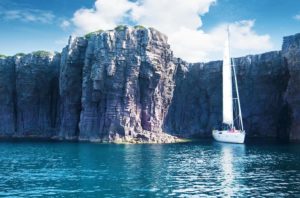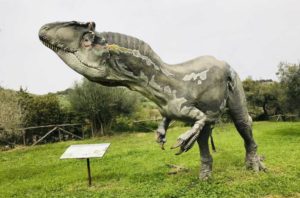Geology of Sardinia
Sardinia, an enchanting island nestled in the Mediterranean, holds within its geology a fascinating story of ancient civilizations, dramatic transformations, and unique landscapes.
From the majestic mountain ranges to the rugged coastlines, Sardinia’s geological history spans millions of years, shaping not only its physical features but also influencing the flora, fauna, and human civilizations that have called this island home. Join us on a journey through time as we explore the captivating geology of Sardinia.
The Ancient Continent of Greater Adria

Image Source: Bigthink.com
Recent geologic research has shed light on the existence of an ancient continent called Greater Adria, which played a significant role in shaping the landmasses we know today. Over a span of more than 100 million years, Greater Adria broke away from the African plate and underwent a series of movements and transformations. Portions of this ancient continent submerged under the European plate, while others rose above it, creating a complex network of mountain ranges and land formations.
The Apennines, parts of the Alps, ranges in Greece, Turkey, and even Sardinia itself were once compressed and located next to each other within Greater Adria. This discovery provides a crucial context for understanding the geological history of Sardinia, as it highlights the island’s connection to larger continental shifts and emphasizes the significance of its land formations.
The Dynamic Formation of Sardinia
Sardinia’s geological story begins over 500 million years ago, characterized by a volatile and dynamic environment. The island is situated in a stable continental phase, which sets it apart from other regions of Italy known for seismic activity. This stability has allowed Sardinia’s geology to preserve its ancient features, providing a window into the past.

The foundation of Sardinia’s geology lies in its mineral kingdom, which has shaped the island’s landscapes over millions of years. The diverse mix of rock types, from sedimentary to volcanic, contributes to the unique formations found across the island. Jutting angles of sedimentary rock layers, limestone formations at the center of the island, and the wear of rock surfaces all tell a tale of time and change.
Mining and the Influence of Geology
The geology of Sardinia has not only shaped its physical features but also influenced the development of human civilizations on the island. As early as 8000 years ago, the ancient inhabitants of Sardinia began mining obsidian, a type of volcanic glass. This valuable resource played a crucial role in the island’s trade and cultural exchange, as obsidian was highly sought after for its use in tools and weapons.

Old mine carts in the Planu Sartu mine tunnel Galleria Henry near the mining village of Buggerru, Sardinia Italy
Evidence of talc mining dating back to 3000 BC demonstrates the island’s rich mineral resources. The Nuragic Civilization, which thrived on Sardinia from around 1800 to 238 BC, engaged in copper mining, further utilizing the island’s geological wealth. The presence of these mining activities reflects the close relationship between Sardinia’s geology and its human inhabitants throughout history.
The Nuraghe: Ancient Stone Testaments

One of the most fascinating remnants of Sardinia’s ancient civilization is the nuraghe, a unique stone structure found exclusively on the island. These impressive megalithic towers, built by the Nuragic Civilization, stand as testaments to the advanced architectural knowledge of their time.
The construction of nuraghe required a deep understanding of the land’s geology, as the stones had to be carefully selected and arranged to ensure stability. Some nuraghe structures incorporate large limestone blocks, while others utilize basalt or granite. The strategic placement of these towers also speaks to the Nuragic people’s understanding of the island’s topography and defensive strategies.
The Enigmatic Domus de Janas

Sardinia is also home to a mysterious phenomenon known as the domus de janas, or “house of fairies.” These rock-cut tombs, dating back to the Neolithic period, are believed to have served as burial chambers for the island’s ancient inhabitants. Carved into the limestone cliffs, these intricate structures showcase the skill and craftsmanship of Sardinia’s early civilizations.
The limestone formations that house the domus de janas reflect the island’s geological diversity. The soft, easily workable nature of limestone made it an ideal material for carving these elaborate tombs. The domus de janas are not only a testament to Sardinia’s geological resources but also offer valuable insights into the island’s spiritual and cultural practices.
A Land of Legends and Oral History
The ancient history of Sardinia is not limited to physical structures and geological formations. The island is steeped in legends and oral history, passed down through generations. These tales often intertwine with the landscapes and geological features of the island, further highlighting the deep connection between Sardinia’s geology and its cultural heritage.
Legends of mythical creatures, such as the “Janas” or fairies, are closely associated with the domus de janas and the limestone cliffs they inhabit. These stories serve as a reminder of the symbiotic relationship between the people and the land, where geological formations became the backdrop for folklore and imagination.
Preserving Sardinia’s Geological Heritage
Sardinia’s geology and its historical significance are a treasure worth preserving. The rich tapestry of rock formations, mineral resources, and ancient structures provide valuable insights into the island’s past and contribute to our understanding of human history. It is essential to protect and conserve these geological treasures for future generations to appreciate and study.
Efforts are underway to raise awareness about Sardinia’s geological heritage and promote sustainable practices that prioritize the preservation of the island’s natural landscapes. By fostering a deep appreciation for the interplay between geology and culture, we can ensure that Sardinia’s geological legacy continues to inspire and educate.
Exploring Sardinia’s Geological Wonders
If you’re captivated by the geology of Sardinia, there are numerous opportunities to explore its wonders firsthand. From hiking through the rugged mountains to discovering hidden caves and coastal formations, the island offers a wealth of geological marvels to discover. Whether you’re a professional geologist or a curious traveler, Sardinia’s landscapes will leave you in awe of the forces that have shaped this remarkable island.
Conclusion
The geology of Sardinia is a testament to the island’s ancient past and the intricate interplay between land and civilization. From the ancient continent of Greater Adria to the megalithic nuraghe and the enigmatic domus de janas, Sardinia’s geological heritage unravels a captivating story of time, change, and human ingenuity. By appreciating and preserving this geological legacy, we can gain a deeper understanding of our shared history and the profound influence of the natural world on human development.



